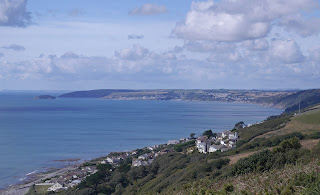Looe
The final day of our four-day progress along the SWCP in Cornwall. We leave our B&B and walk down the hill to Looe's Victorian Bridge and follow the west Quay. The view back is not quite the Grand Canal in Venice, but it's not bad. One thing which was very noticeable walking along beside the river was how clear the water was. The lower left corner of the photo shows a bronze statue of a Grey Seal. This depicts Nelson, who was apparently a familiar sight in South Cornish harbours before settling in Looe until his death in 2003.
Before leaving the town, we pass the church of St Nicholas. Pevsner says it is mainly 1852 and 1862, but was endowed before 1330 and previously used as a school and a guildhall.
Further along, there is a great view across to East Looe's banjo pier. Its role is to protect the harbour entrance.
When we reached the quiet, residential area of Hannafore we were struck by these Cormorants sitting, as Cormorants do, on offshore rocks, and the complex pattern of ripples spreading across the remarkably calm sea. Rame Head, our companion on each day of walking can be seen on the horizon.
Where Hannafore ends, a gate leads to a large grassy area where the path follows the curve of the coast. We soon realised that, as the SWCP Guide suggests, this was going to be one of the most popular stages of the Path: every few minutes it seemed that another couple would hove into view behind us. Later, after a bit of a climb, there is a nice view across Port Nadler Bay to Looe Island and Rame Head.
Turning the unnamed headland soon brings you in sight of Talland Bay. There is a nice little cafe in this attractive small bay which was doing a roaring trade refreshing the passing walkers.
It was now 1.25 miles to Polperro (although an National Trust sign confidently asserted 2 miles). Soon after leaving Talland Bay, the location of Looe could be discerned by plotting the route of the small boats entering and leaving the harbour.
Eventually you turn the corner and get a glimpse of it, but it is not until you are really quite close that the wonderful, picturesque harbour can be fully seen and appreciated.
Polperro dates from the 13th century as a fishing village and the wars of the 18th century bought wealth and fame from smuggling. We had a wander around its narrow streets and then phoned for a cab (unusually from a public call box as there was no mobile signal) and returned to Looe to head home after a splendid four days' walking.
Conditions: cloudy and grey, cooler than on previous days.
Distance: 5 miles.
Map: Explorer 107 (St Austell and Liskeard).
Rating: Four stars. In truth we didn't enjoy this leg as much as we had expected to. The prevailing greyness was a bit depressing, the path was the busiest we have ever experienced (except on the short section from Lulworth to Durdle Door) and perhaps we were a bit tired.









































